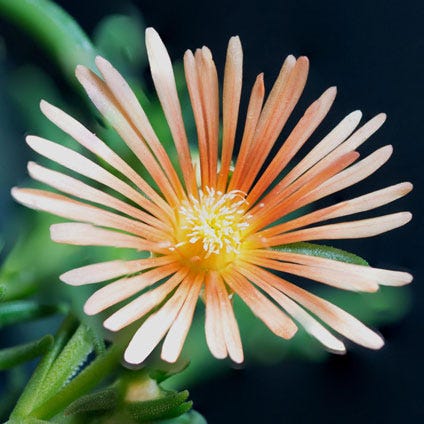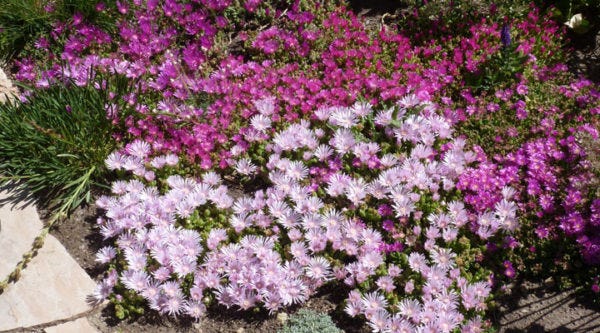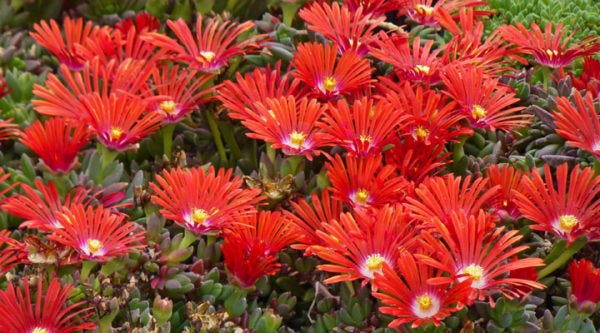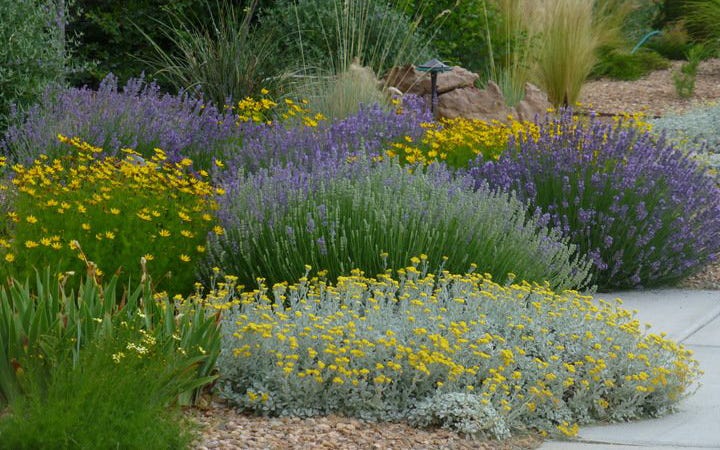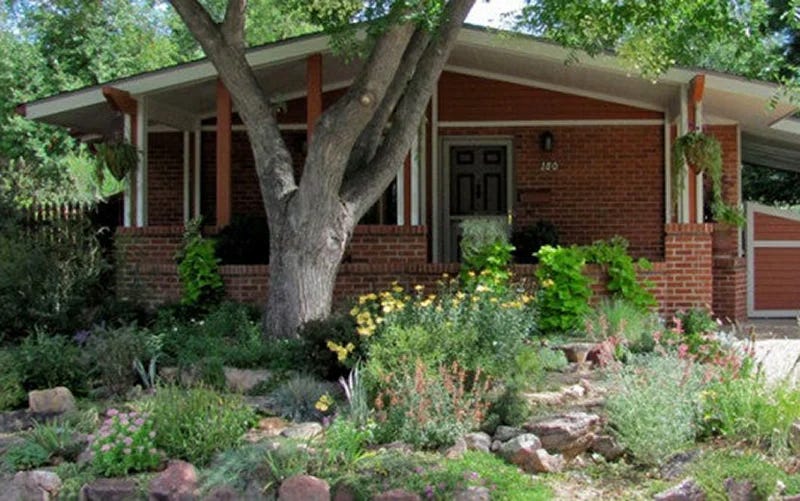How To Grow and Care For Cold Hardy Ice Plant (Delosperma)
by David Salman, Founder of High Country Gardens
I've been in the greenhouse business long enough to remember when Purple Ice Plant (Delosperma cooperi) was first introduced to the gardening community in the early 1990's by Panayoti Kelaidis of Denver Botanic Garden. It was a groundbreaking new plant introduction, the first of its genus to be discovered as cold hardy. This beautiful plant was a huge hit with Front Range Colorado gardeners. We now have many outstanding cold hardy ice plant selections to enjoy, and their use as succulent groundcovers has extended well beyond Colorado.
Ice Plants are native to Africa, with the best cold-hardy species originating from South Africa's lofty Drakensberg Mountains, mountains of the Western Cape, and the cold plateaus of the Great Karoo desert. And thanks to the continuing efforts of Mr. Kelaidis and Colorado's Plant Select® program, the cultivars now available provide a wide range of colors from which to choose, including yellow, orange, purple, scarlet, pink, magenta, bi-color, and more in between. For those interested in providing garden habitat for pollinators, Delosperma are exceptional nectar sources for honeybees.
Where Ice Plants Grows Best
Ice Plants are most reliably perennial in the drier, less humid climates of the western US. Delosperma tend to be annuals in cold, wet zone 4 and 5 climates like Madison, Chicago, and Cincinnati, but will be longer lived in the zone 6-8 areas of the Appalachian mountains and Eastern Seaboard. (Remember that many drought-tolerant plants are one or two zones less cold hardy in wetter climates.) It should be mentioned that in regions where Ice Plants are annuals in the ground, they should be used as container plants as they are fast-growing and colorful when cascading over the edges of their pots.
Cultural Advice for Healthy Ice Plants
Keys to the successful cultivation of Delosperma:
- Plant them in a sunny spot with fast-draining soil. Sandy, sandy loam or gravelly soils are best. In drier climates, garden loam is fine, but avoid clay in all regions.
- Plant by mid-summer in colder climates to establish themselves for winter. Fall planting is recommended in hot summer climates of the Southwest US.
- Water them regularly (weekly) during the heat of the summer, as Delosperma come from areas of South Africa that get summer rains.
- But keep them dry over the winter months. In regions where snow stays on the ground over winter, I recommend covering the plants with a piece of row crop cover (frost blanket) to keep their foliage and crowns dry.
- Ice Plants love gravel mulch and do best when the stems grow over the top of the gravel which keeps their roots moist and their leaves and stems dry (by not sitting in contact with wet soil over the winter). Other fast drying mulch materials like pine needles or medium textured bark chips are also suitable.
- Let them dry out in the fall by stopping or greatly curtailing their irrigation. They need to shrink down and harden off for the cold winter to come. Lush, actively growing plants in late fall often are killed by the first hard frost.
- Prune out any winter-damaged stems in mid-spring.
- Only fertilize once in the fall using organic or natural fertilizers. Ice plants are very prone to winter kill when fertilized frequently during the growing season as they keep growing into the fall and stay plump with water in their leaves.
- To cover larger areas with Ice Plants, space new transplants 15-18" apart (closer for smaller rock garden varieties) with a minimum of soil preparation. A handful of Yum Yum Mix and a little compost in each planting hole is enough.
Recommended Varieties
Delosperma dyeri Red Mountain® Flame - 2015 Plant Select® Award Winner. This is my introduction that I discovered in a batch of seed grown Delosperma dyeri plants that had accidentally hybridized with an unknown variety. The large scarlet-orange flowers cover the plant beginning in mid-spring for about 4 weeks. This selection is reliably cold hardy to zone 6. I'm not kidding when I recommend sunglasses for viewing the brilliant flowers in the mid-day sun. Flame has excellent heat tolerance and is recommended for hotter, drier planting sites.
Delosperma 'Alan's Apricot' - 2016 Plant Select® Award Winner. A new hybrid introduced by Alan Tower of Denver, CO is long blooming and very cold hardy. Possibly the most cold hardy next to D. congestum , D. nubiginum and 'Lesotho Pink'. The plant blooms all summer with large pink-fading-to-apricot flowers. Some afternoon shade shows off the pastel-colored flower best.
Delosperma ashtonii 'Blut' - The very best long-blooming selection that covers its dark green, slightly flattened leaves with a blanket of dark magenta flowers. The handsome foliage is reliably evergreen and it turns a nice plum color over the winter months for additional ornamental interest. Good cold hardiness and xeric, this is an exceptionally long-lived ice plant. Discovered by nurseryman Kelly Grummons of Arvada, CO.
Delosperma Lavender Ice - 2009 Plant Select® Award Winner - A wonderful, long blooming selection that covers itself with huge pastel lavender-pink flowers for much of the growing season. I recommend mixing 'Lavender Ice' with 'Blut' and other magenta or pink-flowered ice plants to show off its superb flowers. The reliably evergreen foliage turns purplish in color over the winter. Introduced by Perennial Favorites Nursery in Rye, CO.
Delosperma sp. 'Lesotho Pink' - I selected this superb variety from seed collected at an elevation of 11.000 ft. in the high peaks of Lesotho (the mountainous, landlocked country in the middle of South Africa). The bright green foliage forms a tight growing, mat that covers itself in early to mid-spring with a carpet of bright pink flowers. Very cold hardy, this is often the first of the cold hardy Ice Plants to bloom in spring. Does best at higher elevations and areas with cooler summers; not a good choice for hot climates. Needs water in the summer heat.
Delosperma Fire Spinner® - 2012 Plant Select® Award Winner. The flowers of Fire Spinner® are an incendiary combination of orange and purple that cover the plant in late spring. A big planting of it will be the highlight of your late spring garden. Note: Fire Spinner® should not be planted in regions with warm winter weather, as it will not chill the plant sufficiently to flower. Best flowering occurs in zones 5-8.
Shop Delosperma
The Legacy of David Salman | High Country Gardens founder David Salman was a pioneer of waterwise gardening, a passionate plant explorer, and a charismatic storyteller. His commitment to cultivating a palette of beautiful waterwise plants transformed gardening in the American West.


